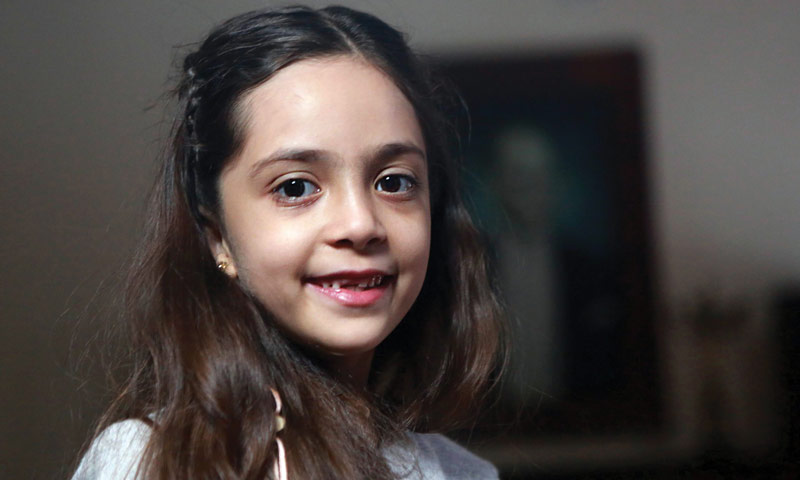



At the beginning of the demonstrations in Syria, many children became famous for being part of the revolutionary actions, such as ‘Nasmat Al-Thawra’ (The Breeze of Revolution) — this girl from Aleppo led a number of demonstrations and the protestors repeated revolutionary slogans and songs after her.
However, these children’s fame soon began to have a different shape in media dominated by either political or commercial propaganda; people, accordingly, started taking sides: Some supported the phenomenon; others refused or opposed it.
Today, Syrian children like Alan Kurdi, Omran Daqneesh, and Bana al-Abed, are in the world’s spotlight even though the oldest of them is just eight years old. The image of these children is beyond their control and, most importantly, beyond their well after they have been turned into international symbols.
Dr. Jalal Nofel, a psychiatrist, told Enab Baladi that one of the conditions that rule taking someone’s photo is asking for his or her own permission. Most of the time, publishers do not seek to attain a permission. Therefore, we can say that these children have been exploited and abused.
It does not matter if the photo of a child is dangerous [abusive] or not, he added; UNICEF has set guidelines for child photography. Whether children are being helped or their positive traits are being represented, these guidelines are often not followed.
A child like Alan Kurdi, the Syrian child who drowned on one of the Turkish shores in September 2015 while his family was trying to flee to Europe, boarding the wave of war escaping people, cannot be questioned whether he would like his photo to be published or not. Neither his age nor his comprehension or the cruel abuse he faced, abuse that led to his death, make him eligible to give an answer.
However, other children are still alive, like Omran Daqneesh, whose image in an ambulance after being pulled from a damaged building after an airstrike on his home in the northern city of Aleppo in August 2016 started to spread. He was wiping his dazed face, full of blood and dust, which aroused global sympathy.
Though Omran’s photo is important for documenting the violence of the Syrian regime and its allies against civilians, the photo was soon used for political advertisement after the regime’s control over Aleppo’s eastern neighborhoods and he, with his father, appeared on a loyalist media outlet to support the regime’s discourse.
Zain, a Kuwaiti telecommunications company, in an advertisement against terrorism, also used Omran. The ad mixed the Syrian regime’s victims with those of the ‘Islamic State’ organization although a number of Syrian observers do not find any difference between the two sides; [both are victimizers]. However, with the international tendency to support Assad, it is necessary to attribute the crime to its owner without manipulation.
“The more the child is dissatisfied with the image promoted by the media, the more powerful is the impact created by the image reminding him or her of a bad event. For example, Omran’s photo, which might suggest to him, whenever he sees it in the future, that he is a stunned and a helpless person. Though the photo is important in terms of documentation, it was bad in the moral and humanitarian sense,” said Dr. Nofal.
Bana al-Abed also gained a wide international fame for her tweets on Twitter during the siege of eastern Aleppo and when the Syrian regime forces and its allies stormed the city. However, she surprised the world by publishing a book titled Dear World. The American Simon & Schuster Publishing House published the book and organized a signing ceremony at New York Law School for a girl, who is only eight years old.
Dr. Nofel said that it is important to focus on how every child is given care, and how his or her surrounding reacts to its fame. Then, we can decide what do. We either try to support the child, in case negative effects existed or seek to enhance the experience’s advantages with regulating its dimensions.
The psychiatrist said that we need to deal with fame according to the individualistic case of each child for the advantages and disadvantages depend on the social network supporting the child. The effects, positive or negative, also depend on how abusive the photo was, whether the photo had represented the child as a victim or a hero and the child’s positioning, whether it was for the benefit of people, who are older than him or her, or to scandalize a certain party.
The doctor also pointed to photos which show children with weapons, describing them as a war crime, considering these photos as the worst thing that has been circulated to promote military action.
Some Syrian families, who have been interviewed by Enab Baladi, prefer to be careful and take it easy in their judgment on famous children, especially that there is a whole life waiting for them; the thing which gives these children the chance to express their own desires in a better manner. The opportunities that these children received might be the beginning of a blessed life, a life their parents could not have.
if you think the article contain wrong information or you have additional details Send Correction